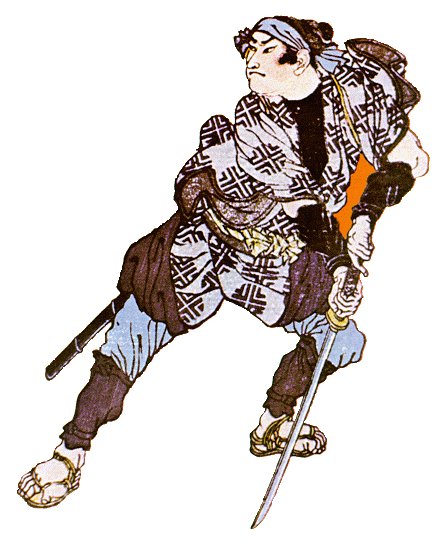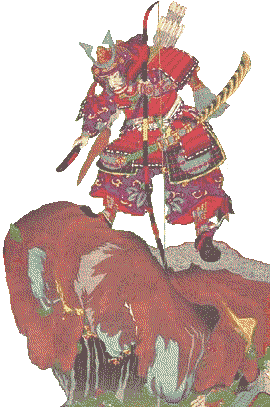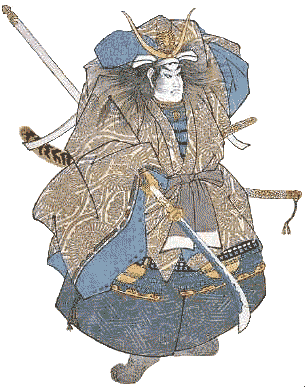Japan’s urban aristocracy finally lost control
of the government at the end of the twelfth century, when two powerful
military clans, the Taira and the Minamoto, battled for supremacy (Time,
9). It was in this era, the Gempei Wars, that the classic conception
of the samurai was forged: highly skilled, professional warriors reminiscent
of the knights of feudal Europe with their fine armor and weapons as well
as their devotion to their lord. After the annihilation of the Taira,
Yoritomo of the Minamoto established himself as the first shogun, setting
up a military regime, the Bakufu, in the city of Kamakura. The emperor,
far away in the luxurious city of Kyoto, would be reduced in status to
a figurehead until the nineteenth century.
The shogunate further encouraged the rise to prominence
of the samurai as a separate class, most obviously distinguished by their right (and obligation) to bear arms. Each samurai belonged
either to a feudal domain or the Bakufu. Those of the two-sworded
class who belonged to neither were called ronin (literally, “wave men”)
or lordless samurai (Omino, xvii). The most powerful samurai took
over feudal domains and claimed the title of daimyo, swearing their allegiance
to the shogun as lower ranking samurai swore allegiance to them. Under
the Bakufu, Japan would experience a time of nominal peace, and would not
see a major war until the invasion of the Mongols a century after the establishment
of the shogunate.
by their right (and obligation) to bear arms. Each samurai belonged
either to a feudal domain or the Bakufu. Those of the two-sworded
class who belonged to neither were called ronin (literally, “wave men”)
or lordless samurai (Omino, xvii). The most powerful samurai took
over feudal domains and claimed the title of daimyo, swearing their allegiance
to the shogun as lower ranking samurai swore allegiance to them. Under
the Bakufu, Japan would experience a time of nominal peace, and would not
see a major war until the invasion of the Mongols a century after the establishment
of the shogunate.
The short age of stability after the founding
of the Bakufu, ended with the Mongol invasion. Unable to provide
enough land to reward the samurai for their service, the reigns of power
were taken by Go-Daigo in the 1330s. However, Go-Daigo would be forced
to flee Kyoto after his defeat at the hands of Ashikaga Takauji.
While Go-Daigo set up court in the south, Takauji placed a second emperor
on the throne in Kyoto (Time, 10). The southern emperor finally agreed
to step down in 1392 after decades of bloody civil war.
Further unrest would ensue for the next hundred
years in a period known as the Sengoku Jidai, the “age of the country at
war.” Daimyo fought daimyo over disputed successions and squabbles over
land, leading to a series of small wars in which the lofty moral code of
the samurai, which included unquestioning loyalty and obedience, was observed
more in the breach than in the practice (Sinclair, 14). However,
this time of violence would prove extremely beneficial to the Japanese
economy.
Merchants thrived as the daimyo’s need for
weapons, armor, and basic necessities rose, and guilds and other organizations
formed to safely transport goods (Time, 10). As trade flourished,
so too did art, and many of the great literary and cultural achievements
of Japan would come about during this era. Buddhism, particularly
Zen, one of the primary influences on the samurai class, also became more
widespread and would have a dramatic effect on Japanese culture.
It was also during this era that Christianity would find its way to Japan
by way of Portuguese traders, who would introduce another Western innovation
to the Japanese.
Hideyoshi completed the unification of Japan
and is remembered for his patronage of culture and of the arts, but he
is guilty of his share of blunders. The most far reaching of these
was his ill-conceived invasion of Korea in 1592, attempted in part as a
way of directing the energies of the many ronin who had become a public
nuisance after the end of the Sengoku Jidai. The first invasion attempt
met with encouraging success early on despite being fraught with command
problems, but was halted by the intervention of the Chinese and the skill
of the Korean navy. A second attempt, launched in 1597, was even
less successful than the first, but the samurai were spared a long war
by Hideyoshi’s death in 1598 (Turnbull, The Book of the Samurai, 102).
Tokugawa Ieyasu was the last of the three,
ending opposition to his rule in 1600 at the Battle of Sekigahara.
The side that a daimyo found himself on at this pivotal battle would dictate
to a large extent his family’s social status for the next 250 years (Sinclair,
17). Tokugawa moved the shogunate to Edo, modern Tokyo, and his family
would hold the post until 1867, leading to a period of relative peace.
It was at this time that the samurai were more
formally established as a ruling class. The mark of the samurai became
the wearing of the daisho, or paired long and short swords, the
dai-to and sho-to. It was also in this period that
the samurai code of bushido was formalized, principally in Hagakure, by
Yamamoto Tsunetomo. Hagakure begins with the words “The Way of the
Samurai is found in death,” a sentence which exemplifies the constant readiness
of samurai to sacrifice their lives for their master. It is for this
reason that the cherry blossom was adopted as a symbol of the samurai,
a reminder of both the vibrance and brevity of their lives. Education
was also emphasized by bushido, and it should also be noted that Tsunetomo
was an adherent of the Wang Yang Ming school of Confucian philosophy, which
taught that knowledge should always be accompanied by action, action that
was swift and immediate (Turnbull, Samurai Warlords, 143).
With the support of the samurai and strict
enforcement of government policies, particularly the exclusion of foreigners,
the Tokugawa shogunate ushered in a new era of peace that would last for
two centuries. It was in this period that many samurai, dedicated
as they were to their new role as administrators and devoid of opportunities
to practice, simply forgot how to fight. The diary of Asahi Bunzaemon,
which records twenty-six years of samurai life during this period, includes
many accounts of such samurai. There were instances of forgetful
samurai who left their swords at a theater or tea house only to realize
their blunder after returning home. There is even the pathetic account
of a samurai whose short sword was stolen right out of its sheath as he
watched a popular dance performance in town (Omino, xx).
The death blow would come to the samurai with
the forced opening of Japan’s ports by Commodore Perry in 1853. This
sign of weakness by the Tokugawa shogun lent support to steadily growing
movements in favor of a return of power to the emperor. The Meiji
Restoration, beginning with the overthrow of the last shogun in 1887, would
meet sporadic opposition by tradition-minded samurai, but bullets would
overcome swords once again and the samurai disappeared as a class before
the turn of the century. This marked the end of centuries of military
rule and the rise of modern Japan.
|


 by their right (and obligation) to bear arms. Each samurai belonged
either to a feudal domain or the Bakufu. Those of the two-sworded
class who belonged to neither were called ronin (literally, “wave men”)
or lordless samurai (Omino, xvii). The most powerful samurai took
over feudal domains and claimed the title of daimyo, swearing their allegiance
to the shogun as lower ranking samurai swore allegiance to them. Under
the Bakufu, Japan would experience a time of nominal peace, and would not
see a major war until the invasion of the Mongols a century after the establishment
of the shogunate.
by their right (and obligation) to bear arms. Each samurai belonged
either to a feudal domain or the Bakufu. Those of the two-sworded
class who belonged to neither were called ronin (literally, “wave men”)
or lordless samurai (Omino, xvii). The most powerful samurai took
over feudal domains and claimed the title of daimyo, swearing their allegiance
to the shogun as lower ranking samurai swore allegiance to them. Under
the Bakufu, Japan would experience a time of nominal peace, and would not
see a major war until the invasion of the Mongols a century after the establishment
of the shogunate.